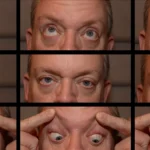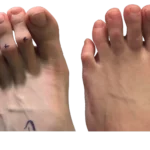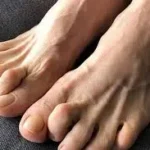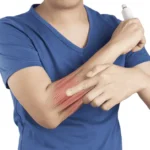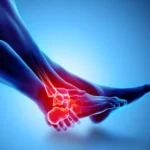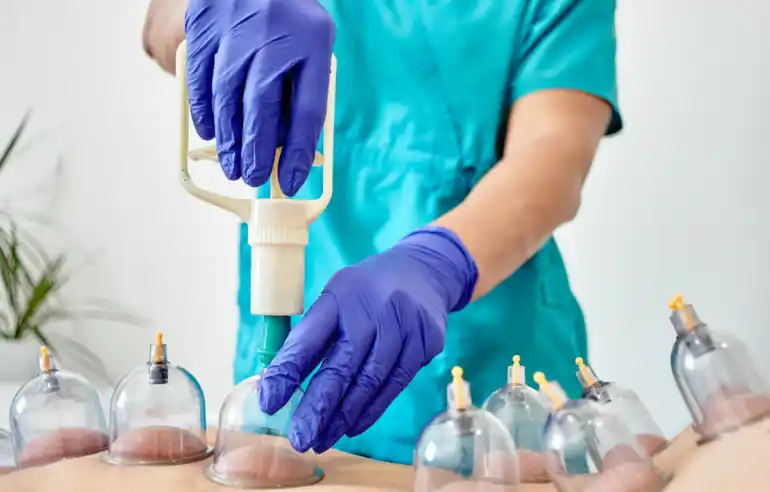Overview
Swan neck deformity is a characteristic finger deformity commonly seen in conditions affecting the hand’s joints, tendons, or connective tissues particularly in rheumatoid arthritis. It involves a distinct postural change in the finger, where there is hyperextension at the proximal interphalangeal (PIP) joint and flexion at the distal interphalangeal (DIP) joint, giving the finger a shape that resembles a swan’s neck, hence the name.
In swan neck deformity, the normal balance between the flexor and extensor mechanisms of the finger is disrupted. This imbalance can occur due to damage to the ligaments, tendons, or joint capsule, leading to instability and deformity. Over time, this deformity can interfere with daily hand functions such as gripping, pinching, and writing.
At DMPhysios, a leading clinic in Noida specializing in spine and sports conditions with patient-centered rehabilitation, expert physiotherapists focus on restoring finger mobility, function, and strength in individuals affected by swan neck deformity through evidence-based interventions.
Symptoms
The symptoms of swan neck deformity depend on the underlying cause and the severity of the deformity. Common signs and symptoms include:
- Visible deformity: The finger develops a noticeable curve, hyperextended at the middle joint and flexed at the fingertip.
- Difficulty in finger movement: Performing fine motor tasks like buttoning clothes, writing, or gripping objects becomes difficult.
- Pain and stiffness: Pain around the affected joint, particularly during movement or pressure, is common.
- Weak grip strength: Because the deformity affects tendon balance, hand grip becomes weaker.
- Joint instability: The PIP joint may feel loose or unstable due to stretching of the ligaments.
- Swelling and tenderness: In cases associated with inflammatory conditions such as rheumatoid arthritis, swelling and joint tenderness are frequent.
- Functional limitation: The finger may not be able to straighten or bend completely, reducing overall hand dexterity.
Recognizing these symptoms early and consulting a professional at DMPhysios in Noida can help prevent the deformity from progressing and improve outcomes through timely physiotherapy intervention.
Types of Swan Neck Deformity
Swan neck deformity can be categorized based on its cause or mechanism:
- Primary Swan Neck Deformity:
This form occurs due to an imbalance between the extensor and flexor tendons of the finger. The PIP joint becomes hyperextended while the DIP joint bends downward. It’s typically associated with rheumatoid arthritis or ligament laxity. - Secondary Swan Neck Deformity:
This type occurs as a result of trauma, neurological disorders, or tendon injuries that indirectly cause the deformity. For instance, an untreated mallet finger injury can lead to a secondary swan neck deformity over time. - Congenital Swan Neck Deformity:
Rarely, some individuals may be born with structural imbalances that predispose them to this deformity, although this is uncommon.
Causes
There are multiple causes of swan neck deformity, most of which affect the structures supporting the PIP joint:
- Rheumatoid Arthritis:
This is the most common cause. Chronic inflammation weakens the tendons and ligaments around the PIP joint, leading to hyperextension and subsequent DIP flexion. - Trauma or Injury:
Fractures, ligament tears, or dislocations involving the PIP joint can disturb the balance of finger tendons and result in swan neck deformity. - Nerve Damage:
Conditions such as cervical spinal cord injuries or ulnar nerve palsy can disrupt muscle control, causing imbalances that produce deformities in the fingers. - Mallet Finger Injury:
An untreated mallet finger (where the extensor tendon at the fingertip is damaged) can create tension imbalance, eventually leading to swan neck deformity. - Ehlers-Danlos Syndrome or Ligamentous Laxity:
People with hypermobile joints or connective tissue disorders have weaker ligaments, which can make them prone to finger deformities like the swan neck pattern. - Volar Plate Laxity:
The volar plate prevents hyperextension at the PIP joint. Weakness or stretching of this structure results in instability and hyperextension. - Post-surgical or Post-traumatic Changes:
After tendon surgery or injuries that alter tendon tension, the imbalance can give rise to deformities in the long term.
Risk Factors
Certain factors increase the likelihood of developing swan neck deformity, including:
- Chronic rheumatoid arthritis
- Previous hand or finger injuries
- Connective tissue disorders
- Nerve injuries (especially involving the ulnar or median nerve)
- Joint laxity or congenital hypermobility
- Poor post-injury rehabilitation
- Age-related degenerative changes
- Genetic predisposition
Patients at DMPhysios in Noida often present with swan neck deformity secondary to either rheumatoid arthritis or trauma. Early diagnosis and a structured rehabilitation plan significantly improve long-term hand function.
Treatment
The treatment of swan neck deformity aims to restore function, prevent progression, and relieve pain. The choice between conservative and surgical management depends on the severity of deformity and underlying cause.
Conservative (Non-surgical) Management
- Splinting:
- A ring splint or oval-8 splint is commonly used to prevent PIP hyperextension while allowing finger flexion.
- Night splints can help maintain proper joint alignment.
- Medications:
- Anti-inflammatory medications are prescribed to reduce pain and swelling, especially in rheumatoid arthritis-related deformities.
- Steroid Injections:
- In certain cases, corticosteroid injections may be administered to control local inflammation.
- Activity Modification:
- Avoiding excessive finger stress, using ergonomic tools, and adapting daily hand functions help minimize strain on the affected finger.
Surgical Management
In advanced or unresponsive cases, surgical correction may be required. Procedures include:
- Soft tissue reconstruction to restore tendon balance.
- PIP joint fusion (arthrodesis) in severe deformities.
- Joint replacement (arthroplasty) for advanced arthritis.
- Volar plate advancement to stabilize the joint and limit hyperextension.
However, post-surgical rehabilitation remains essential for optimal recovery and that’s where DMPhysios provides comprehensive post-operative physiotherapy programs tailored to individual needs.
Physiotherapy Treatment
At DMPhysios, physiotherapy plays a vital role in managing swan neck deformity, whether it’s treated conservatively or surgically. The goal is to restore joint mobility, improve hand function, strengthen supporting structures, and prevent further deformity.
1. Pain and Inflammation Control
- Use of cryotherapy (ice therapy) and ultrasound therapy to reduce inflammation and discomfort.
- TENS (Transcutaneous Electrical Nerve Stimulation) for pain modulation
- Accelerated Healing Therapy: For better healing and recovery
- Gentle massage and mobilization to improve local circulation.
2. Joint Protection Techniques
- Education on ergonomic hand use during activities of daily living.
- Instruction on proper splint use to prevent hyperextension.
- Avoiding overexertion of the affected joint during recovery.
3. Range of Motion Exercises
- Active and passive PIP flexion exercises to maintain mobility.
- Tendon gliding exercises to improve finger flexibility.
- Blocking exercises where one joint is stabilized while moving another to strengthen isolated tendons.
- Controlled stretching of tight structures to balance tendon forces.
4. Strengthening Exercises
- Rubber band finger extensions: To improve extensor tendon strength.
- Theraputty exercises: For grip and intrinsic muscle strengthening.
- Isometric holds targeting the lumbricals and interossei muscles.
- Gradual progression from light resistance to functional hand exercises.
5. Neuromuscular Re-education
- Proprioceptive and coordination training to improve hand control.
- Mirror therapy and task-specific practice to enhance motor relearning post-injury or surgery.
6. Functional Rehabilitation
- Incorporation of activities like writing, buttoning, or gripping to integrate hand function into daily life.
- Custom-made splints may be used during tasks to maintain alignment.
The DMPhysios team in Noida ensures a patient-centered approach, every program is tailored according to the severity of deformity, hand function goals, and lifestyle requirements. Consistent follow-up, exercise progression, and ergonomic education make rehabilitation at DMPhysios both effective and sustainable.
Prevention
While not all cases of swan neck deformity can be prevented, especially those caused by systemic diseases like rheumatoid arthritis, the risk can be minimized through:
- Early treatment of joint inflammation and prompt management of arthritis.
- Proper rehabilitation after finger or hand injuries to prevent tendon imbalances.
- Regular hand exercises to maintain joint mobility and strength.
- Use of protective splints in patients with known ligament laxity.
- Ergonomic adaptations during daily tasks to avoid repetitive strain.
- Routine physiotherapy check-ups at specialized centers like DMPhysios in Noida to monitor joint health and detect early signs of deformity.
Conclusion
Swan neck deformity is a complex condition that affects the hand’s functionality, appearance, and quality of life. Early diagnosis, appropriate medical treatment, and a structured physiotherapy program can significantly restore movement, prevent progression, and enhance overall hand function.
At DMPhysios, a trusted physiotherapy clinic in Noida known for its excellence in managing spine and sports conditions, the rehabilitation of swan neck deformity is handled with precision, care, and a patient-centered approach. Their team of skilled physiotherapists uses a blend of manual therapy, exercise prescription, and advanced modalities to ensure that each patient regains optimal hand function and independence.
If you or someone you know is struggling with swan neck deformity or any other hand condition, don’t wait for it to worsen.
Contact DMPhysios in Noida today for expert evaluation, personalized care, and a comprehensive rehabilitation program designed to get your hands back to full function because at DMPhysios, your recovery is our priority.


